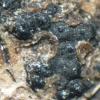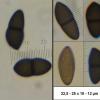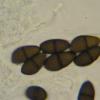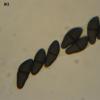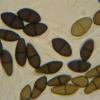
31-10-2025 09:19
 Lothar Krieglsteiner
Lothar Krieglsteiner
Can somebody provide me with a file of:Rogerson CT

09-08-2025 13:13
 Maria Plekkenpol
Maria Plekkenpol
Hello,Yesterday I found these on burnt soil. Apoth

28-10-2025 19:33
 Nicolas Suberbielle
Nicolas Suberbielle
Bonjour à tous,Je voudrais votre avis sur cette r

25-11-2016 13:54
 Stephen Martin Mifsud
Stephen Martin Mifsud
Hi, I found numerous seeds of Washingtonia robusta

28-10-2025 22:22
 Bernard Declercq
Bernard Declercq
Hello.I'm searching for the following paper:Punith

28-10-2025 15:37
Carl FarmerI'd be grateful for any suggestions for this strik

28-10-2025 11:29
 Tanja Böhning
Tanja Böhning
Hello, I found this very small (ca 0,5mm) yellow
Someone gave me this fungus found on Sarothamnus scoparius.
Black perithecia globulose, 350 high x 300 wide, with a distinct short ostiole,immersed and tearing periderm.
Hamathecium composed of paraphyses, hyaline, septate, 2 µm wide, and cylindrical and bitunicate asci.
Ascospores brown, 1-septate, surrounded by a hyaline sheath, verruculose, generally asymetrical, 22,5-25 x 10-12 µm.
These precedent features are according to Didymosphaerella spartii.
BUT :
We can see hyaline rounded apical ends on the ascospores (=pore ?). I never read in litterature that this king of fungus has this feature. And I don't believe that Petrak, Chlebicki, Fabre (it comes from Vaucluse, his area of prospection) and other mycologists never see it.
What do you think ?
Do I search in another direction (Microthelia complex for example) ?
Alain

as-tu considéré le genre Dothidottia?
Je te retiens au courant.
Alain
Des nouvelles.
Il s'agirait bien d'une espèce de "Botryosphaeria" (s. l.) à spores brunes uniseptées reversées dans le genre Dothidotthia.
Deux espèces sont proches : B. viticola qui vient sur Vitis et qui a des spores presque identiques et B. iberica qui vient sur Quercus ilex, possédant des spores de même taille mais sans les appendices.
On est tout proche.
Si quelqu'un connait une espèce de ce groupe venant sur S. scoparius, je suis preneur !
Ma question : B. viticola peut-il se rencontrer sur un autre support tel ce genêt ?
Alain
Pärdon pour la nouvelle terminologie :
il faut les appeler Spencermartinsia viticola et Dothiorella iberica.

